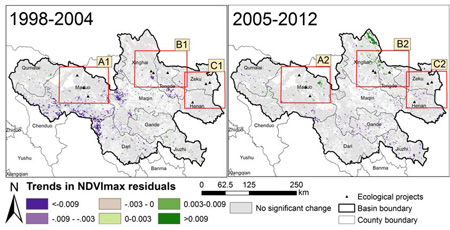Ecological projects are an important and vital method to help ecosystem adaptation and restoration in response to the environment change and human interference. The accurate and objective assessment of ecological projects will assist ecosystem management and adaption.
Taking the central Tibetan Plateau as the study area, Dr. CAI Hongyan, Prof. XU Xinliang and Prof. YANG Xiaohuan from the Institute of Geographic Sciences and Natural Resources Research, Chinese Academy of Sciences, identified at a pixel level, the spatial patterns of human-induced grassland degradation/ restoration, and explored where and to what extent the ecological projects influenced the grassland variation.
They found that before the projects (between 1998 and 2004), human-induced degradation characterized the grassland. However, a general grassland restoration was detected after the projects from 2005 to 2012. Moreover, over 60% of project plots had positive trends in the NDVI residuals.
From the spatial patterns, project-induced restoration was detected in the western and northern regions, such as Maduo, Dongde and Xinghai counties. For the eastern regions, the human-induced degradation has been generally mitigated and yet not reversed after the projects.
The results will provide useful information for better ecological management practices in the central Tibetan Plateau, and will also provide insights into the assessment of ecological projects in temperature–precipitation jointly determined environments.
The related work has been published in Ecological Engineering (Cai Hongyan, Yang Xiaohuan, Xu Xinliang. Human-induced grassland degradation/restoration in the central Tibetan Plateau: The effects of ecological protection and restoration projects. Ecological Engineering, 2015, 83:112-119. doi:10.1016/j.ecoleng.2015.06.031).
This study was supported by the National Science & Technology Pillar Programand the National Natural Science Foundation of China.
 |
|
Spatial distribution of human-induced grassland change during the periods of 1998-2004 and 2005-2012; the grassland restoration projects were implemented since 2005(Image by Dr. CAI Hongyan) |